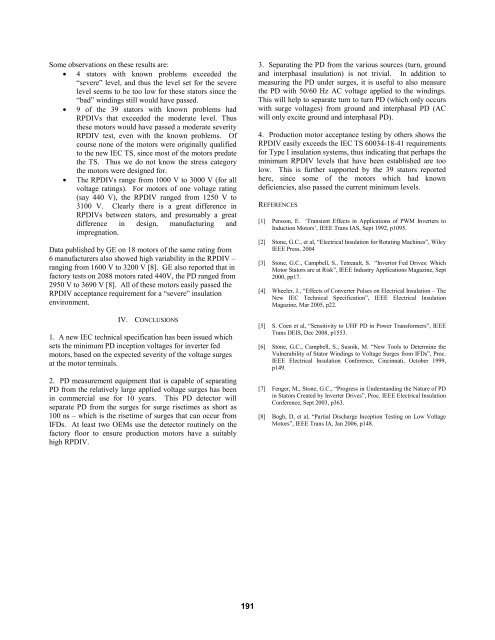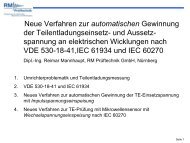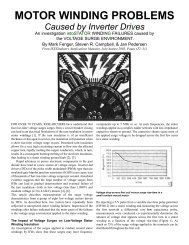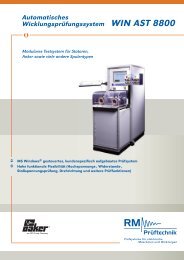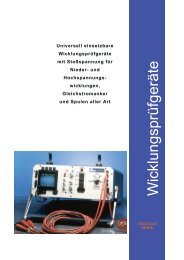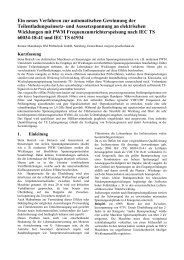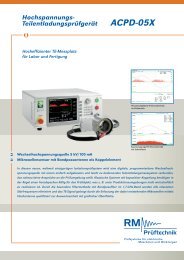Partial Discharge Testing of Random Wound Stators ... - IEEE Xplore
Partial Discharge Testing of Random Wound Stators ... - IEEE Xplore
Partial Discharge Testing of Random Wound Stators ... - IEEE Xplore
You also want an ePaper? Increase the reach of your titles
YUMPU automatically turns print PDFs into web optimized ePapers that Google loves.
Some observations on these results are:<br />
• 4 stators with known problems exceeded the<br />
“severe” level, and thus the level set for the severe<br />
level seems to be too low for these stators since the<br />
“bad” windings still would have passed.<br />
• 9 <strong>of</strong> the 39 stators with known problems had<br />
RPDIVs that exceeded the moderate level. Thus<br />
these motors would have passed a moderate severity<br />
RPDIV test, even with the known problems. Of<br />
course none <strong>of</strong> the motors were originally qualified<br />
to the new IEC TS, since most <strong>of</strong> the motors predate<br />
the TS. Thus we do not know the stress category<br />
the motors were designed for.<br />
• The RPDIVs range from 1000 V to 3000 V (for all<br />
voltage ratings). For motors <strong>of</strong> one voltage rating<br />
(say 440 V), the RPDIV ranged from 1250 V to<br />
3100 V. Clearly there is a great difference in<br />
RPDIVs between stators, and presumably a great<br />
difference in design, manufacturing and<br />
impregnation.<br />
Data published by GE on 18 motors <strong>of</strong> the same rating from<br />
6 manufacturers also showed high variability in the RPDIV –<br />
ranging from 1600 V to 3200 V [8]. GE also reported that in<br />
factory tests on 2088 motors rated 440V, the PD ranged from<br />
2950 V to 3690 V [8]. All <strong>of</strong> these motors easily passed the<br />
RPDIV acceptance requirement for a “severe” insulation<br />
environment.<br />
IV. CONCLUSIONS<br />
1. A new IEC technical specification has been issued which<br />
sets the minimum PD inception voltages for inverter fed<br />
motors, based on the expected severity <strong>of</strong> the voltage surges<br />
at the motor terminals.<br />
2. PD measurement equipment that is capable <strong>of</strong> separating<br />
PD from the relatively large applied voltage surges has been<br />
in commercial use for 10 years. This PD detector will<br />
separate PD from the surges for surge risetimes as short as<br />
100 ns – which is the risetime <strong>of</strong> surges that can occur from<br />
IFDs. At least two OEMs use the detector routinely on the<br />
factory floor to ensure production motors have a suitably<br />
high RPDIV.<br />
3. Separating the PD from the various sources (turn, ground<br />
and interphasal insulation) is not trivial. In addition to<br />
measuring the PD under surges, it is useful to also measure<br />
the PD with 50/60 Hz AC voltage applied to the windings.<br />
This will help to separate turn to turn PD (which only occurs<br />
with surge voltages) from ground and interphasal PD (AC<br />
will only excite ground and interphasal PD).<br />
4. Production motor acceptance testing by others shows the<br />
RPDIV easily exceeds the IEC TS 60034-18-41 requirements<br />
for Type I insulation systems, thus indicating that perhaps the<br />
minimum RPDIV levels that have been established are too<br />
low. This is further supported by the 39 stators reported<br />
here, since some <strong>of</strong> the motors which had known<br />
deficiencies, also passed the current minimum levels.<br />
REFERENCES<br />
[1] Persson, E. ‘Transient Effects in Applications <strong>of</strong> PWM Inverters to<br />
Induction Motors’, <strong>IEEE</strong> Trans IAS, Sept 1992, p1095.<br />
[2] Stone, G.C., et al, “Electrical Insulation for Rotating Machines”, Wiley<br />
<strong>IEEE</strong> Press, 2004<br />
[3] Stone, G.C., Campbell, S., Tetreault, S. “Invertor Fed Drives: Which<br />
Motor <strong>Stators</strong> are at Risk”, <strong>IEEE</strong> Industry Applications Magazine, Sept<br />
2000, pp17.<br />
[4] Wheeler, J., “Effects <strong>of</strong> Converter Pulses on Electrical Insulation – The<br />
New IEC Technical Specification”, <strong>IEEE</strong> Electrical Insulation<br />
Magazine, Mar 2005, p22.<br />
[5] S. Coen et al, “Sensitivity to UHF PD in Power Transformers”, <strong>IEEE</strong><br />
Trans DEIS, Dec 2008, p1553.<br />
[6] Stone, G.C., Campbell, S., Susnik, M. “New Tools to Determine the<br />
Vulnerability <strong>of</strong> Stator Windings to Voltage Surges from IFDs”, Proc.<br />
<strong>IEEE</strong> Electrical Insulation Conference, Cincinnati, October 1999,<br />
p149.<br />
[7] Fenger, M., Stone, G.C., “Progress in Understanding the Nature <strong>of</strong> PD<br />
in <strong>Stators</strong> Created by Inverter Drives”, Proc. <strong>IEEE</strong> Electrical Insulation<br />
Conference, Sept 2003, p363.<br />
[8] Bogh, D, et al, “<strong>Partial</strong> <strong>Discharge</strong> Inception <strong>Testing</strong> on Low Voltage<br />
Motors”, <strong>IEEE</strong> Trans IA, Jan 2006, p148.<br />
191


